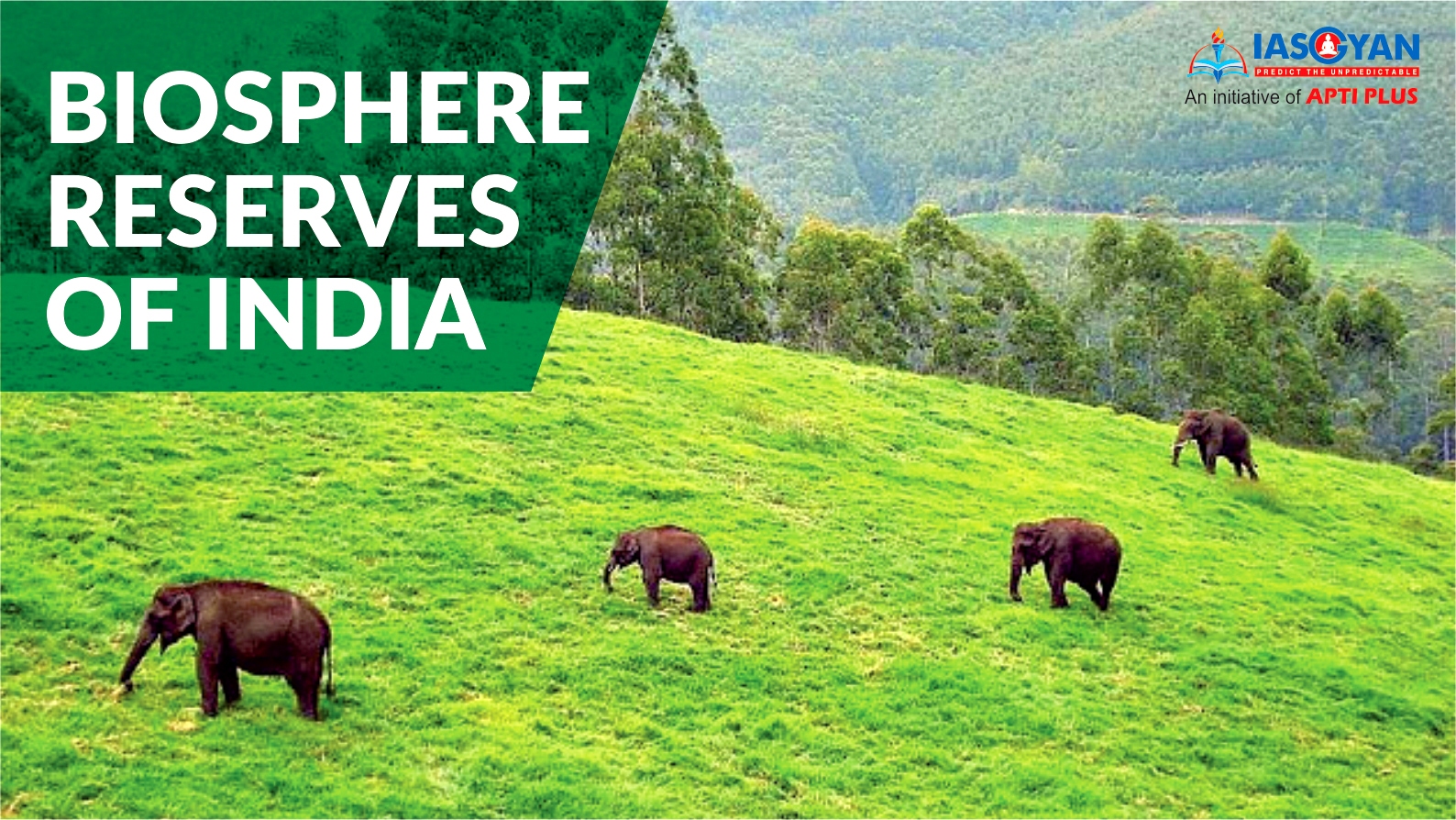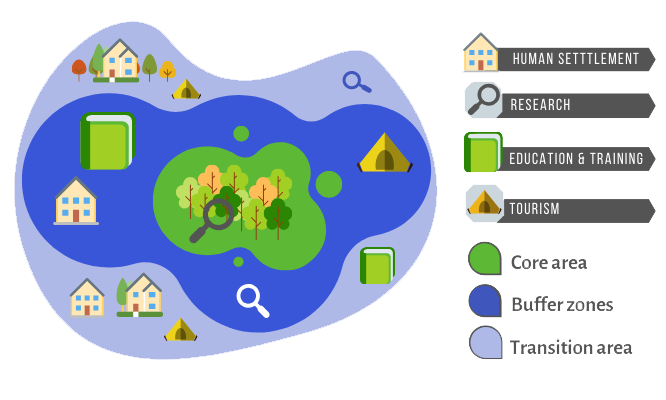





Core Areas
It comprises a strictly protected zone that contributes to the conservation of landscapes, ecosystems, species and genetic variation
Buffer Zones
It surrounds or adjoins the core area(s), and is used for activities compatible with sound ecological practices that can reinforce scientific research, monitoring, training and education.
Transition Area
The transition area is where communities foster socio-culturally and ecologically sustainable economic and human activities.
The Indian government has established 18 biosphere reserves (categories roughly correspondingly to IUCN Category V Protected areas) to protect larger areas of natural habitat than a typical national park or animal sanctuary, and that often include one or more national parks or reserves, along with buffer zones that are open to some economic uses. Protection is granted not only to the flora and fauna of the protected region, but also to the human communities who inhabit these regions, and their ways of life.
Twelve of the eighteen biosphere reserves are a part of the World Network of Biosphere Reserves, based on the UNESCO Man and the Biosphere (MAB) Programme list.
|
Name |
States/ UT |
Year |
|
|
1 |
Nilgiri Biosphere Reserve |
Tamil Nadu, Kerala and Karnataka |
2000 |
|
2 |
Gulf of Mannar Biosphere Reserve |
Tamil Nadu |
2001 |
|
3 |
Sundarbans Biosphere Reserve |
West Bengal |
2001 |
|
4 |
Nanda Devi Biosphere Reserve |
Uttarakhand |
2004 |
|
5 |
Nokrek Biosphere Reserve |
Meghalaya |
2009 |
|
6 |
Pachmarhi Biosphere Reserve |
Madhya Pradesh |
2009 |
|
7 |
Simlipal Biosphere Reserve |
Odisha |
2009 |
|
8 |
Great Nicobar Biosphere Reserve |
Andaman & Nicobar Islands |
2013 |
|
9 |
Achanakmar-Amarkantak Biosphere Reserve |
Chhattisgarh, Madhya Pradesh |
2012 |
|
10 |
Agasthyamalai Biosphere Reserve |
Kerala and Tamil Nadu |
2016 |
|
11 |
Khangchendzonga National Park |
Sikkim |
2018 |
|
12 |
Panna Biosphere Reserve |
Madhya Pradesh |
2020 |
|
S. No. |
Name |
Location |
State |
Type |
Key fauna |
|
1 |
Nilgiri Biosphere Reserve |
Part of Waynad, Nagarhole, Bandipur and Mudumalai, Nilambur, Silent Valley |
Tamil Nadu, Kerala and Karnataka |
Western Ghats |
Nilgiri tahr, tiger, lion-tailed macaque |
|
2 |
Nanda Devi Biosphere Reserve |
Parts of Chamoli District, Pithoragarh District & Bageshwar District |
Uttarakhand |
Western |
Snow leopard, Himalayan black bear |
|
3 |
Gulf of Mannar |
Indian part of Gulf of Mannar extending from Rameswaram island in the north to Kanyakumari in the south of Tamil Nadu and Sri Lanka |
Tamil Nadu |
Coasts |
Dugong |
|
4 |
Nokrek |
In west Garo Hills |
Meghalaya |
Eastern hills |
Red panda |
|
5 |
Sundarbans |
Part of delta of Ganges and Brahmaputra river system |
West Bengal |
Gangetic Delta |
Royal Bengal tiger |
|
6 |
Manas |
Part of Kokrajhar, Bongaigaon, Barpeta, Nalbari, Kamrup and Darrang Districts |
Assam |
Eastern Hills |
Asiatic elephant, tiger, Assam roofed turtle, hispid hare, golden langur, pygmy hog |
|
7 |
Simlipal |
Part of Mayurbhanj district |
Odisha |
Deccan Peninsula |
Gaur, royal Bengal tiger, Asian elephant |
|
8 |
Dihang-Dibang |
Part of Siang and Dibang Valley |
Arunachal Pradesh |
Eastern Himalaya |
Mishmi takin, musk deer |
|
9 |
Pachmarhi Biosphere Reserve |
Parts of Betul District, Hoshangabad District and Chhindwara District |
Madhya Pradesh |
Semi-Arid |
Giant squirrel, flying squirrel |
|
10 |
Achanakmar-Amarkantak Biosphere Reserve |
Part of Annupur, Dindori and Bilaspur districts |
Madhya Pradesh, Chhattisgarh |
Maikala Hills |
Four-horned antelope, Indian wild dog, sarus crane, white-rumped vulture, sacred grove bush frog |
|
11 |
Great Rann of Kutch |
Part of Kutch, Morbi, Surendranagar and Patan districts; the largest biosphere reserve in India. |
Gujarat |
Desert |
Indian wild ass |
|
12 |
Cold Desert |
Pin Valley National Park and surroundings; Chandratal and Sarchu & Kibber Wildlife Sanctuary |
Himachal Pradesh |
Western |
Snow leopard |
|
13 |
Khangchendzonga National Park |
Parts of Kangchenjunga |
Sikkim |
East Himalayas |
Snow leopard, red panda |
|
14 |
Agasthyamalai Biosphere Reserve |
Neyyar, Peppara and Shenduruny Wildlife Sanctuary and their adjoining areas |
Kerala, Tamil Nadu |
Western Ghats |
Nilgiri tahr, Asian elephant |
|
15 |
Great Nicobar Biosphere Reserve |
Southernmost of the Andaman and Nicobar Islands |
Andaman and Nicobar Islands |
Islands |
Saltwater crocodile |
|
16 |
Dibru-Saikhowa |
Part of Dibrugarh and Tinsukia districts |
Assam |
Eastern Hills |
White-winged wood duck, water buffalo, black-breasted parrotbill, tiger, capped langur |
|
17 |
Seshachalam Hills |
Seshachalam Hill Ranges covering parts of Chittoor and Kadapa districts |
Andhra Pradesh |
Eastern Hills |
Slender loris |
|
18 |
Panna |
Part of Panna and Chhattarpur districts in Madhya Pradesh |
Madhya Pradesh |
Disclaimer: No copyright infringement of images intended.
© 2026 iasgyan. All right reserved